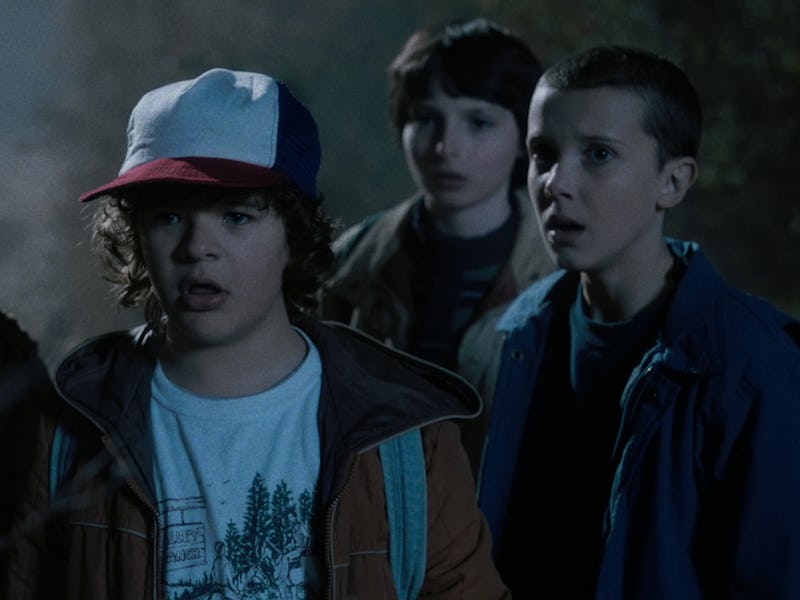Netflix's 'Stranger Things' is the Perfect Kind of Sci-Fi Vagueness
Why concealing instead of revealing makes for a better genre narrative strategy.

The fundamental mystery at the heart of a sci-fi TV show or movie should be solved, otherwise whats the point in watching? The answer is inevitably built into the narrative from the start, and more often than not, the success of a show like, say, Netflix’s new supernatural thriller Stranger Things, depends on the details it shows along the way to solve that mystery. You can’t over-explain the complexities of your story, but you can’t be so vague as to cheat the audience out of a fulfilling experience either. So how can a show like Stranger Things that features a dimension-jumping monster, a government conspiracy, braindead research subjects, and a runaway telekinetic child all make sense enough to cohere into one of the summer’s best TV shows? It does that by not giving too much away.
Lately, there has been a pervasive habit of narrative hand-holding plaguing these kinds of stories. Blame the emergence of cinematic universes and short attentions spans for audiences feeling the need to have everything spelled out for them. This annoying characteristic goes beyond stories explaining simple motivations, and instead errs on the side of being an egregious unspoken prerequisite. Everything needs an explanation now because the assumption is that certain details wouldn’t make sense without one.
We need to find out the origin story of one particular superhero because three movies from now he’s going to reference it, but the Marvel movies usually play it safe and are narratively boring. We need to find out each precise step that the astronaut will take to get himself off the stranded planet, but there’s no real narrative tension in The Martian because nothing is revealed that isn’t just a series of facts that progress the pre-determined plot along. We need to have tons of flashbacks to rub the audience’s noses in supposedly big revelations in the wannabe cryptic network police procedural drama, which makes a show like Blindspot seem edgy for your older relatives who still think shows like The Big Bang Theory are hilarious.
The emphasis on making everything intelligible comes from the assumption that filmmakers or TV show creators simply don’t want to leave the audience confused, and anything labelled as challenging will likely be skipped over. This kind of thing works to varying degrees in the mind boggling big budget films of Christopher Nolan like Inception or Interstellar. The opposite argument, where an obscure approach to unfolding the story’s pillars gets you willfully obtuse examples. Take theAlien prequel Prometheus, a movie that becomes so vague in its origins-of-man story that it feels absurd; this is the precedent audiences have set.
Stranger Things, however, strikes the perfect balance. It grounds itself in a very recognizable suburban situation, and, much like the Stephen King stories or Steven Spielberg movies it takes a heavy inspiration from, runs amok from there with its sci-fi moments.
From there we find out that a secret government agency is conducting MK Ultra-related experiments nearby, causing female test subjects to potentially give birth to children with superhuman mental powers. The agency eventually conducts further tests on the special children to hopefully develop powers to be able to spy on the Soviet Union using telekinesis, but following one of the child subject’s escape the experiments cause an inter-dimensional rift that unleashes a monster that promptly kidnaps one of the local kids and sets the show’s narrative on its way.
Even though this all happens in the first eight minutes of the show, it takes the full eight episodes of the first season to understand it. But instead of divulging everything after those eight episodes, the show concocts clever ways to gradually let it all out. Much of it limited to the adolescent mindset understanding of main characters Mike, Lucas, and Dustin who are searching for their kidnapped best friend Will.
They try to make sense of Eleven, the escaped telekinetic girl whom they befriend, by calling her “The Weirdo” for her mind powers. The monster is referenced as the Demogorgon, a creature from their favorite game Dungeons & Dragons. And they try to justify the alternate dimension that Eleven visits that inadvertently attracts the Demogorgon by simply referring to it as “The Upside Down” after Eleven tries to explain where she’s gone by turning over their D&D board.
The supernatural details are smartly glossed over with a sense of Spielbergian awe. So when Joyce, Will’s mother played by Winona Ryder, clings to a balled up collection of Christmas lights and starts speaking to the electrically charged bulbs because she thinks its her son, we learn that anybody or anything trying to bridge the gap between two dimensions causes a temporary — but focused — power surge.
Even the government conspiracy isn’t specific. We’re simply meant to infer from Episode 5, entitled “The Body,” that the anti-Russian telikinetic experiments on children are for spying — the void-like vacuum seen in Eleven’s flashbacks show her observing a Russian-speaking man decked out in a ushanka. The phrase MK Ultra isn’t even uttered until Hopper and Joyce go searching in Episode 6, “The Monster,” for a former experiment patient named Terry Ives who might be Eleven’s mother despite the fact that she miscarried in her third trimester due to the experiment fallout.
Stranger Things works because it teases, unfurls and conceals. You won’t get all the answers you want, but you’ll get the ones you need. It’s all the better for it because being vague doesn’t take away from the experience of watching it all play out in front of you. There’s nothing strange about that.